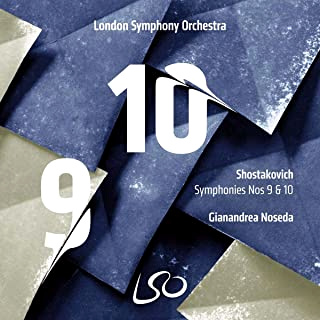

Symphony No 9 in E-Flat Major, Op. 70 (1945) Symphony No 10 in E Minor, Op. 93 (1953)
It seems many people dismiss the Symphony No 9 in E-Flat Major, Op. 70 by Dmitri Shostakovich (1906-1975) as a trivial bagatelle when compared to the two massive symphonies that antecede it. And yet it's arguably one of his most potently lurid political statements in which he flips the proverbial finger at the governing authorities. With five movements running at under 30 minutes it's very short (only about 4 minutes longer than the single opening movement of the 10th symphony), but in typical Shostakovich fashion it covers plenty of emotional ground. From the jovial opening movement, through the ominous second with its glacial sounding strings and doleful ending, the short but aggressive Presto, the Largo with its haunting bassoon lines, and last but not least the closing movement where during its final few minutes you would swear you've just stepped into the big tent of a three-ring circus. And because the war was over Stalin and his cohorts were expecting to hear a glorious finale to match Beethoven's 9th, but instead were served a sardonic testimonial of their brutal hegemony. As in this review of the Symphony No. 5, conductor Gianandrea Noseda "gets" the joke and fully understands the composer's motivation, and delivers a gripping account. The "live" audio recording is exceptionally good, but a note of caution to the sound engineers: don't position the microphones so close as to hear the flutists breathing in between phrases. It's distracting and not what you would hear sitting in the concert hall.
On the other hand the Symphony No 10 in E Minor, Op. 93, composed a long eight years after the 9th, is a completely different kettle of fish. Galina Vishnevskaya, the great Russian opera singer and wife of cellist Mstislav Rostropovich, defined the Tenth as "a composer's testament of misery, forever damning a tyrant". Having been completed six months after the death of Stalin in March of 1953, one would think that it should have been dressed in brighter colors, but there's a dark and profound disquiet to it, especially within its long opening movement. Elucidation of this could be as pointed out in the booklet notes: "There is evidence that it may have been planned and some of it composed during 1951, or even earlier - that is, in the aftermath of the notorious 1948 attack on so many Soviet composers, and on Shostakovich in particular." What's truly remarkable about the music of Shostakovich is that he doesn't need to resort to melodramatics to convey sadness or bleak despair, but instead in typical Shostakovich style, long and sinuous lines in the lower strings more than convey the proper atmosphere and desired effect. And the ominous nature of these opening lines in the double basses that lead to the great emotive upheaval in the middle of the first movement is well captured by Gianandrea Noseda and the string players of the LSO. The enigmatic flute melody at the close of the movement is also quite effective here. The prodigious brutality and maniacal level of violent energy contained in the short second movement is suitably dispatched here as the members of the LSO play as if their lives depended on it. The ill winds of the first movement return to open the fourth and final movement, but eventually about midpoint the mood lifts, and once again in typical Shostakovich fashion, the brutality and despair are vanquised, and the symphony ends on a somewhat hard-earned optimistic and triumphant note, with Noseda and the LSO members giving it all they've got.
Jean-Yves Duperron - February 2021